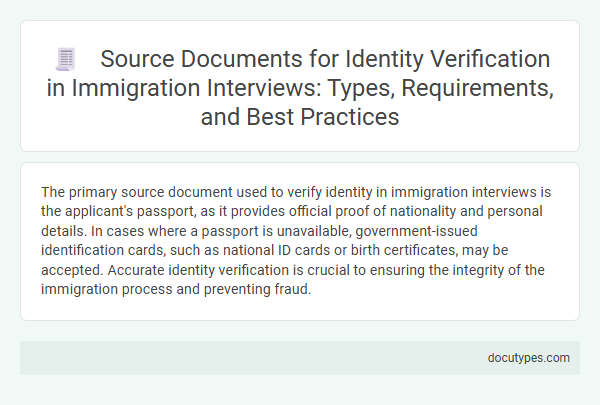The primary source document used to verify identity in immigration interviews is the applicant's passport, as it provides official proof of nationality and personal details. In cases where a passport is unavailable, government-issued identification cards, such as national ID cards or birth certificates, may be accepted. Accurate identity verification is crucial to ensuring the integrity of the immigration process and preventing fraud.
Introduction to Identity Verification in Immigration Interviews
Identity verification in immigration interviews is a critical step to ensure the applicant's authenticity and eligibility. The primary source document used is a government-issued photo identification, such as a passport or national ID card. These documents provide official proof of the applicant's identity, essential for accurate and secure immigration processing.
Importance of Source Documents in Immigration Processes
Source documents such as passports, national identity cards, and birth certificates are essential in verifying identity during immigration interviews. These documents provide undeniable proof of an individual's identity and nationality, ensuring the legitimacy of the immigration process. Accurate verification using trusted source documents helps prevent fraud and facilitates effective decision-making by immigration authorities.
Primary Identity Documents: Passports, National IDs, and Birth Certificates
What source document is used to verify identity in immigration interviews? Primary identity documents such as passports, national IDs, and birth certificates are the most commonly accepted forms of verification. These documents provide official proof of your identity and citizenship status during the immigration process.
Secondary Supporting Documents: Utility Bills, Bank Statements, and More
Secondary supporting documents play a crucial role in verifying identity during immigration interviews. These documents complement primary identification to establish residency and personal details.
- Utility Bills - Provide proof of address and residency over a specific period.
- Bank Statements - Show financial transactions that corroborate personal information and residence.
- Other Documents - Includes rental agreements, employment records, and official correspondence to support identity claims.
Using a combination of these secondary documents strengthens the credibility of the applicant's identity verification process.
Special Cases: Minors, Refugees, and Stateless Applicants
| Applicant Category | Primary Source Document for Identity Verification | Special Considerations |
|---|---|---|
| Minors | Birth Certificate or Passport | If unavailable, school records or guardianship documents may be accepted. Parental or guardian accompaniment is often required during the interview to corroborate identity. |
| Refugees | Refugee Travel Document or UNHCR Registration Card | When these documents are missing, affidavits from aid organizations or identity affidavits may be used. Verification may also include biometric data and interviews to confirm the identity. |
| Stateless Applicants | Statelessness Determination Documents or Identity Certificates issued by relevant authorities | In cases where formal documentation is lacking, testimony from community leaders or NGOs can support identity verification. Rigorous examination of personal history helps establish identity. |
| Your Role | Providing Accurate and Authentic Documents | You must ensure all provided documents are genuine and comply with immigration authority requirements to avoid delays in the identity verification process. |
Legal and Regulatory Requirements for Document Submission
Immigration interviews require verifiable source documents to confirm your identity accurately as mandated by legal and regulatory standards. Compliance with these requirements ensures a smooth immigration process and adherence to government protocols.
- Government-issued Photo ID - A valid passport or national identity card is often the primary document used to confirm identity during immigration interviews.
- Regulatory Compliance - Immigration authorities enforce strict rules requiring original or certified copies of documents to prevent fraud and maintain security.
- Document Authenticity - Submitted documents must meet standardized legal criteria, including expiration dates and official seals, to be accepted in identity verification.
Common Pitfalls and Mistakes in Document Preparation
Immigration interviews require a valid source document to verify an applicant's identity, with passports and government-issued photo IDs being the most commonly accepted forms. Proper document preparation is crucial to avoid delays or denials.
Common pitfalls include submitting expired or damaged documents, which can lead to questioning of authenticity. Missing supporting documents such as birth certificates or national ID cards often complicate the verification process. Sometimes, names or dates of birth do not match exactly across documents, causing additional scrutiny or requests for further evidence.
Best Practices for Organizing and Presenting Documents
The primary source document used to verify identity in immigration interviews is typically a government-issued photo identification, such as a passport or national ID card. These documents provide reliable proof of identity and are accepted by immigration authorities worldwide.
Best practices for organizing and presenting documents include arranging them in chronological order and ensuring they are clean, clear, and easily accessible. Your preparation should also involve creating a checklist to avoid missing key documents during the interview process.
Digital Document Submission: Trends and Security Concerns
In immigration interviews, passports and national identity cards serve as primary source documents to verify identity. Recent trends favor digital document submission, streamlining the verification process.
Digital submissions enhance efficiency but raise security concerns such as data breaches and identity theft. Advanced encryption and multi-factor authentication are essential to safeguard sensitive information during digital exchanges.
What Source Document Is Used to Verify Identity in Immigration Interviews? Infographic

